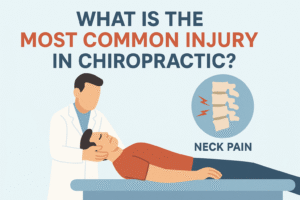
I. Understanding Posture and Its Importance
A. Definition of Good Posture
Good posture refers to the proper alignment of body parts when standing, sitting, or lying down. It involves maintaining a neutral spine, with the ears, shoulders, hips, knees, and ankles in a straight line. Learning how chiropractic helps with posture begins with understanding these fundamentals.
B. Common Postural Problems
- Forward head posture
- Rounded shoulders
- Excessive lumbar lordosis (swayback)
- Anterior pelvic tilt
- Uneven hips or shoulders
C. Health Implications of Poor Posture
Poor posture can lead to various health issues, including:
- Chronic back and neck pain
- Headaches
- Reduced lung capacity
- Digestive problems
- Increased risk of injury
II. Introduction to Chiropractic Care
A. What Is Chiropractic Medicine?
Chiropractic medicine is a healthcare profession that focuses on diagnosing and treating neuromuscular disorders, with an emphasis on manual adjustment of the spine. Knowing how chiropractic helps with posture is a cornerstone of this practice.
B. History and Development of Chiropractic Adjustments
Founded in 1895 by Daniel David Palmer, chiropractic care has evolved into a recognized form of alternative medicine.
C. How Chiropractic Adjustments Work
Chiropractors use their hands or instruments to apply controlled force to joints, enhancing spinal alignment and improving posture and overall function.
III. How Chiropractic Helps with Posture: Alignment and Beyond
A. Spinal Alignment and Its Effect on Posture
Proper spinal alignment is key to good posture. Chiropractic adjustments realign the spine, helping the body maintain healthier posture. This is how chiropractic helps with posture on a structural level.
B. Correcting Muscle Imbalances
Chiropractic care addresses overactive and weak muscles, restoring balance and improving posture over time.
C. Addressing Joint Dysfunction
Adjustments improve joint function and mobility, which support better posture naturally.
IV. Physical Benefits of Chiropractic Care for Posture
A. Reduced Back and Neck Pain
How chiropractic helps with posture also extends to pain relief. Proper alignment reduces the strain that causes chronic discomfort.
B. Improved Flexibility and Range of Motion
With improved spinal and joint function, patients experience better flexibility.
C. Enhanced Athletic Performance
Better posture supports improved balance, coordination, and stamina in athletes and active individuals.
V. Non-Physical Benefits of Improved Posture
A. Increased Confidence and Self-Esteem
Standing tall with aligned posture enhances how others perceive you and how you feel about yourself.
B. Better Breathing and Circulation
How chiropractic helps with posture is evident in how proper spinal alignment allows better lung expansion and blood flow.
C. Improved Digestive Function
Good posture prevents pressure on abdominal organs, aiding digestion.
VI. Chiropractic Techniques for Posture Correction
A. Spinal Manipulation
This is the foundation of how chiropractic helps with posture – realigning the vertebrae.
B. Soft Tissue Therapy
Techniques like myofascial release reduce tension and muscle stiffness, supporting better alignment.
C. Posture Exercises and Rehabilitation
Chiropractors prescribe exercises to strengthen postural muscles and support spinal adjustments.
VII. Complementary Approaches to Posture Improvement
A. Ergonomic Adjustments in Daily Life
Simple changes to desk setup, sleeping positions, and posture habits support chiropractic care.
B. Strengthening Exercises for Postural Muscles
These exercises enhance how chiropractic helps with posture by reinforcing muscular stability.
C. Mindfulness and Body Awareness Techniques
Mindful practices improve awareness of posture throughout the day, making corrections easier.
VIII. Summary: The Long-Term Impact of Chiropractic Care on Posture
How chiropractic helps with posture is through continuous care that realigns the spine, balances the muscles, and enhances body mechanics. Patients who incorporate chiropractic adjustments and home exercises often see long-term improvements in posture and overall well-being.
IX. Frequently Asked Questions
A. How Often Should I Receive Chiropractic Adjustments for Posture Improvement?
The frequency varies, but consistent visits yield better and longer-lasting results.
B. Are Chiropractic Adjustments Safe for Everyone?
Generally safe, but individuals with certain conditions should consult their physician.
C. How Long Does It Take to See Results in Posture Improvement?
Some feel better after just one session, while others may need weeks or months of care.
D. Can Chiropractic Care Help with Posture-Related Headaches?
Yes. Addressing spinal misalignments can relieve tension headaches caused by poor posture.
E. Is Chiropractic Care Covered by Insurance for Posture-Related Issues?
Coverage varies by plan. Many cover chiropractic when medically necessary.




